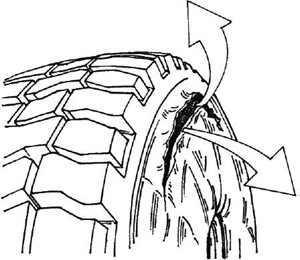Worker injured while inflating truck tyre
This article is from Work Safe Queensland.
In October 2023, a worker sustained head and chest injuries when an inflated truck tyre exploded. Preliminary information suggested a truck tyre exploded when the worker was fitting a re-inflated tyre to the truck. It appeared the inside of the tyre wasn’t inspected prior to inflating and inflation didn’t occur inside a tyre cage.
Safety issues
There are risks to workers being injured while fitting tyres. Problems frequently arise during work involving industrial-type split rims which are used on earth moving machinery, trucks, forklifts and rural-use vehicles, with both bolt together and lock ring type rims.
Over inflation can occur due to unregulated compressed air supply. This can happen when someone is using an air outlet on a workshop or shed compressor without a pressure regulator and pressure gauge, or when bypassing the air pressure regulator, or inflating the tyre/tube higher than the manufacturer’s recommendations.
Some other factors which may contribute to an injury include:
- Mismatch of split rim assemblies (involving all the elements of a rim including the lock rings).
- Retainers not being reassembled as matching sets when more than one rim is being refitted with new tyres.
- Rims being fitted with a new tyre/tube when they are worn, corroded or damaged beyond their serviceable life (according to manufacturers’ standards and recommendations).
Workers have been seriously injured by blasted parts of the tyre/rim assembly or by the force of the sudden release of air pressure which has thrown them to the hard surface floor.
Inflated tyres, particularly truck tyres, contain a large amount of stored energy. Tyres are designed to withstand this, but if they are damaged or have been used while flat (or significantly underinflated), they may fail. Tyre damage due to underinflation cannot always be detected by external inspection. If a tyre fails during inflation, the explosive force can be released resulting in a destructive air blast and the ejection of high-speed particles. If the wheel is not restrained, it can move through the air. The rapid release of this explosive force from a ruptured tyre can result in serious injuries or even death.
Figure 1 – An example of a failure in the side wall of a tyre commonly known as a zipper failure.
Ways to manage health and safety
Effective risk management starts with a commitment to health and safety from those who manage the business. If an incident occurs, you’ll need to show the regulator that you’ve used an effective risk management process. This responsibility is covered by your primary duty of care in the Work Health and Safety Act 2011.
Use the hierarchy of controls to help decide how to eliminate and reduce risks in your place of work. The hierarchy of controls ranks types of control methods from the highest level of protection and reliability to the lowest. It’s a step-by-step approach to eliminating or reducing risks. You must work through the hierarchy of controls when managing risks, with the aim of eliminating the hazard, which is the most effective control.
Possible control measures to prevent similar incidents
If you are a person conducting a business or undertaking (PCBU) where workers are required to repair, maintain, or change heavy vehicle tyres, you must ensure that:
- A regular tyre maintenance schedule is in place which checks tyres for condition, matching, pressure, tread depth and wear patterns.
- A regular maintenance schedule should include the inspection of rims for corrosion, cracking, or damage.
- Rims are inspected for damage or corrosion prior to refitting tyres, and any damaged rims are removed from service.
- All workers undertaking servicing procedures are trained and follow them.
- Tyres, whether new or used, are inspected for defects.
- Tyre and rim assemblies are adequately secured in a safety cage or other portable restraint device prior to inflating the tyre.
- Inform, train, and supervise staff in safe personal positioning and safe procedures during tyre inflation (including actions when a potential tyre failure is identified).
- Potential trajectory paths from a failure and exclusion zones have been identified.
- Workers stand outside of the exclusion zones when seating a tyre bead and inflating tyres above 35 kPa or 5 psi.
- Tyres are only inflated to the recommended pressure.
- The air hose between the clip-on valve nozzle and the remote gauge and trigger is long enough for workers to stay outside of the exclusion zone.
- A remote dump valve is also fitted that is capable of rapidly deflating the tyre in an emergency.
- All safety cages, air-lines and associated equipment are suitable for the task and maintained in a safe working condition.
When maintaining or repairing heavy vehicle tyres or rims, you should deflate the tyres prior to removing from the vehicle. This does not apply to removing wheel tyre assemblies to facilitate other forms of maintenance such as tyre rotation, alignments or brake servicing. However, the wheel assembly should be thoroughly inspected for defects prior to removal.
The most common way to ensure a wheel is adequately secured before inflating is to use a tyre safety cage. The wheel is located in the centre of the cage preventing the wheel or tyre from being ejected in the event of an explosion.
Split rims are also common on heavy machinery. These introduce additional risks associated with over-inflation, incorrect fitment of parts, and failure of wheel components due to damage and corrosion. Multi-piece wheels are an inherently unsafe design.
If a residual risk remains, it must be minimised so far as reasonably practicable by using personal protective equipment (PPE). For example, wearing protective goggles or face shields when working on wheels or tyres.
Administrative control measures and PPE rely on human behaviour and supervision and used on their own tend to be least effective in minimising risks.


